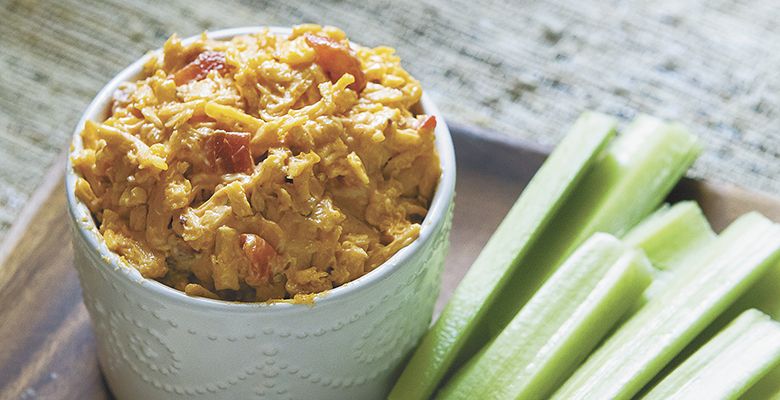Pimento Spreads
Southern staple enjoying culinary comeback
Pimento cheese is one of those uniquely American foods with a fascinating history not quite as Southern it appears. With the recent resurgence in popularity on restaurant menus and upscale versions hitting store shelves, it seemed like a good time to uncover the origins of the recipe.
Known as the "Pâté of the South,” the mixture of grated cheese, mayonnaise, chopped red peppers and spices has been a staple in Southern kitchens for generations. Everyone had a grandma or aunt with a special recipe that would appear on buffets, most often slathered between two slices of white bread stylishly cut into triangles.
Recipes were as varied as the cooks who made them and evoked much controversy as to the “perfect” pimento cheese. Alas, no definitive recipe was out there in print to set the standard. To understand why, we need to return to the true origin of this cheesy spread, which, surprisingly, is not Southern at all.
In fact, pimento cheese was developed as an outgrowth of the industrialized ’convenience foods’ of the early 20th century, when cream cheese and newly available Spanish red peppers, known as pimenton, became popular items of the era. The first recipes were simply a combination of cream cheese and pimentos.
Modeled after the French Neuchatel, a fresh, spreadable cheese, cream cheese was first produced in New York in the 1870s. The major producer, Phenix Cheese, was acquired by Kraft and rebranded as Philadelphia Cream Cheese. It became an exciting new ingredient in both home cooking and commercial products.
By 1900, sweet red peppers were canned and imported from Spain. They soared in popularity for their enticing flavor and bright color. To satisfy the demand, by 1911, farmers in Georgia cultivated a domestic version of the Spanish pepper and invented a way more efficient way to peel them after roasting.
These ’new’ items held wide appeal at a time when ’modern’ home economics and store-bought items were replacing homemade. Print ads and recipes in magazines pushed these industrialized ingredients into the mainstream.
By World War II, pimento cheese sandwiches were a lunchtime staple at soda fountains in all areas of the country. Recipe books of the time mention it as an ingredient, something that would be store-bought in jars or tubs, rather than made at home.
After the war, the popularity of the spread began to wane and commercial production, mostly in New York and Wisconsin, shifted to other cheeses. Crafty Southern cooks, who continued to crave the flavor, created their own recipes to approximate the store-bought spread, which was now more difficult to find.
At the time, Hoop Cheese, a semi-firm cheese made from drained cottage cheese curds pressed into a “hoop” form, was widely available throughout the South, and many home cooks combined it, jarred pimentos, homemade salad dressing and their own unique spin on spices to create their personal approximation of the spread.
As the decades passed, cheddar cheese replaced the hoop cheese and store-bought mayonnaise, with a particular loyalty to Dukes, a regional mayo with less sugar and more egg yolks, replacing the homemade salad dressing.
Regional groceries began stocking industrial products that were mediocre at best. Many — mostly non-Southerners — derided the spread as unsophisticated, but for those who grew up with it, it was familiar and comforting.
As Southern chefs and their cuisine caught on, it was only a matter of time before the naysayers would be won over with a taste of the real deal. Chefs throughout the country now offer house-made versions to add a bit of Southern flair to their menus.
Today, you’ll find recipes that include the traditional orange-hued cheddar, Monterey Jack, smoked Gouda and other cheeses to balance the flavor. Some cheesemakers have even created recipes using their upscale cheeses and a few enterprising businesses are even offering gourmet pimento cheese for retail sale.
Because it is just so easy to make and quite tasty, pimento cheese can easily be added to your repertoire at home. A simple base recipe can be jazzed up in any direction you choose. Make it. Share it. Love it. And you don’t have to be from the South!
Smoky Pimento Cheese
After trying a few different spice combinations, this was a favorite with my family. The smoky paprika was extra tasty. Be creative and riff on the basic recipe to make it uniquely your own.
Ingredients
¾ cup mayonnaise (I used Best Foods/Hellmann’s)
1 teaspoon grainy Dijon mustard
1 tablespoon sweet onion, finely minced
1 teaspoon smoked paprika
* dash of cayenne or Tabasco and black pepper, to taste
¼ cup pimento, chopped
8 ounces sharp cheddar, coarsely grated (I used Tillamook, of course)
Method
1. In a medium bowl, combine mayonnaise, mustard, onion, spices and pimento; stir to combine. Add cheese in two batches, stirring until thoroughly combined.
2. Refrigerate mixture for an hour or, preferably, overnight to allow flavors to meld.
3. Serve cheese on sliced bread, with crackers, or stuffed in celery sticks or small peppers. Also delicious on burgers and sandwiches.



 Christine Hyatt promotes the wonders of fine cheese through food writing, recipe creation, food photography and video. Connect with her on Facebook or
Christine Hyatt promotes the wonders of fine cheese through food writing, recipe creation, food photography and video. Connect with her on Facebook or 







